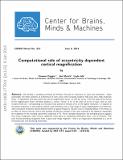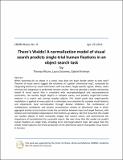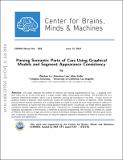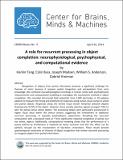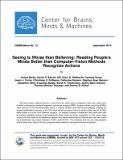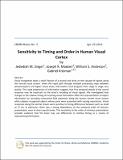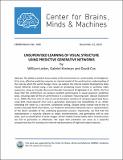Browsing CBMM Memo Series by Subject "Vision"
Now showing items 1-8 of 8
-
Computational role of eccentricity dependent cortical magnification
(Center for Brains, Minds and Machines (CBMM), arXiv, 2014-06-06)We develop a sampling extension of M-theory focused on invariance to scale and translation. Quite surprisingly, the theory predicts an architecture of early vision with increasing receptive field sizes and a high resolution ... -
Human-Machine CRFs for Identifying Bottlenecks in Holistic Scene Understanding
(Center for Brains, Minds and Machines (CBMM), arXiv, 2014-06-15)Recent trends in image understanding have pushed for holistic scene understanding models that jointly reason about various tasks such as object detection, scene recognition, shape analysis, contextual reasoning, and local ... -
A normalization model of visual search predicts single trial human fixations in an object search task.
(Center for Brains, Minds and Machines (CBMM), arXiv, 2014-04-25)When searching for an object in a scene, how does the brain decide where to look next? Theories of visual search suggest the existence of a global attentional map, computed by integrating bottom-up visual information with ... -
Parsing Semantic Parts of Cars Using Graphical Models and Segment Appearance Consistency
(Center for Brains, Minds and Machines (CBMM), arXiv, 2014-06-13)This paper addresses the problem of semantic part parsing (segmentation) of cars, i.e.assigning every pixel within the car to one of the parts (e.g.body, window, lights, license plates and wheels). We formulate this as a ... -
A role for recurrent processing in object completion: neurophysiological, psychophysical and computational evidence.
(Center for Brains, Minds and Machines (CBMM), arXiv, 2014-04-26)Recognition of objects from partial information presents a significant challenge for theories of vision because it requires spatial integration and extrapolation from prior knowledge. We combined neurophysiological recordings ... -
Seeing is Worse than Believing: Reading People’s Minds Better than Computer-Vision Methods Recognize Actions
(2015-12-10)We had human subjects perform a one-out-of-six class action recognition task from video stimuli while undergoing functional magnetic resonance imaging (fMRI). Support-vector machines (SVMs) were trained on the recovered ... -
Sensitivity to Timing and Order in Human Visual Cortex.
(Center for Brains, Minds and Machines (CBMM), arXiv, 2014-04-25)Visual recognition takes a small fraction of a second and relies on the cascade of signals along the ventral visual stream. Given the rapid path through multiple processing steps between photoreceptors and higher visual ... -
UNSUPERVISED LEARNING OF VISUAL STRUCTURE USING PREDICTIVE GENERATIVE NETWORKS
(Center for Brains, Minds and Machines (CBMM), arXiv, 2015-12-15)The ability to predict future states of the environment is a central pillar of intelligence. At its core, effective prediction requires an internal model of the world and an understanding of the rules by which the world ...

